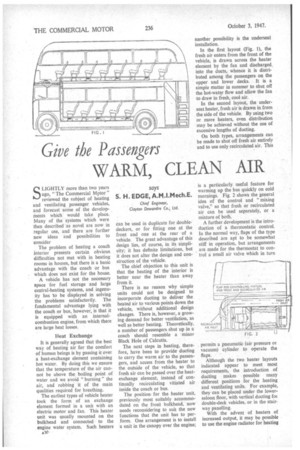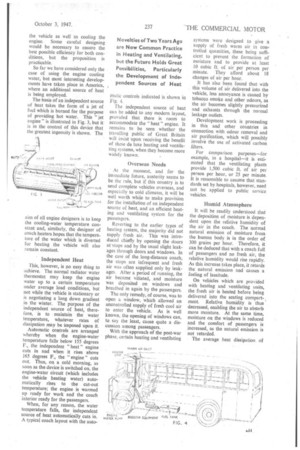WARM, CLEAN AIR
Page 32

Page 33

Page 34

If you've noticed an error in this article please click here to report it so we can fix it.
says
S. H. EDGE, A.M,.I.Mech.E.
Chief Engineer, Clayton Dewandre Co.,. Ltd. SLIGHTLY more than two years ago, "The Commercial Motor" reviewed the subject of heating and ventilating passenger vehicles, and forecast some of the developments which would take place. Many of the systems which were then described as novel are now in regular use, and there are further new ideas and possibilities to consider
The problem of heating a coach interior presents certain obvious difficulties not met with in heating rooms in houses, but there is a basic advantage with the coach or bus which does not exist for the house.
A vehicle has not the necessary space for fuel storage and large central-heating systems, and ingenuity has -to be displayed in solving the problems satisfactorily. The fundamental advantage lying with the coach or bus, however, is that it is equipped with an internalcombustion engine, from which there are large heat losses.
Heat Exchange
It is generally agreed that the best way of heating air for the comfort of human beings is by passing it over a heat-exchange element containing hot water. By doing this we ensure that the temperature of the air cannot be above the boiling point of water and we avoid " burning " the air, and robbing it of the main qualities required for breathing.
The earliest types of vehicle heater took the form of an exchange element formed in a unit with an electric motor and fan. This heater unit was usually mounted on the bulkhead and connected to the engine water system. Such heaters A30
can be used in duplicate for doubledeckers, or for fitting one at the front and one at the rear of a vehicle. The great advantage of this design lies, of course, in its simplicity; it has definite limitations, but it does not alter the design and construction of the vehicle.
The chief objection to this unit is that the heating of the interior is better near the heater than away from it.
There is no reason why simple units could not be designed to incorporate ducting to deliver the heated air to various points down the vehicle, without additional design changes. There is, however, a growing demand for better ventilation, as well as better heating. Theoretically, a number of passengers shut up in a coach should resemble a minor Black Hole of Calcutta.
The next steps in heating, therefore, have been to provide ducting to carry the warm air to the passengers, and access from the heater to the outside of the vehicle, so that fresh air can be passed over the heatexchange element, instead of continually recirculating vitiated air inside the coach or bus.
The positionfor the heater unit, previously most suitably accommodated on the front bulkhead, now needs reconsidering to suit the new functions that the unit has to perform. One arrangement is to install a unit in the canopy over the engine; another possibility is the underseat installation.
In the first layout (Fig. 1), the fresh air enters from the front of the vehicle, is drawn across the heater element by the fan and discharged into the ducts, whence it is distributed among the passengers on the upper and lower decks. It is a simple matter in summer to shut off the hot-water flow and allow the fan to draw in fresh, cool air.
In the second layout, the underseat heater, fresh air is drawn in from the side of the vehicle. By using two or more heaters, even distribution may be achieved without the use of excessive lengths of ducting.
On both types, arrangements can be made to shut off fresh air entirely and to use only recirculated air. This is a particularly useful feature for warming up the bus quickly on cold mornings. Fig. 2 shows the general idea of the control and "mixing valve," so that fresh or recirculated air can be used separately, or a mixture of both.
A further development is the introduction of a thermostatic control. In the normal way, flaps of the type described are apt to be somewhat stiff in operation, but arrangements are made for the thermostat to control a small air valve which in turn permits a pneumatic (air pressure or vacuum) cylinder to operate the flaps. • Although the two heater layouts indicated appear to meet most requirements, the introduction of ducting makes possible many different positions for the heating and ventilating units. For example, they can be placed under the lowersaloon floor, with vertical ducting lot double-deck vehicles, or in the stair. way panelling.
With the advent of heaters of increased output, it may be possible to use the engine radiator for heating the vehicle as well as cooling the engine. Some careful designing would be necessary to ensure the best possible efficiency for both conditions, but the proposition is practicable.
So far we have considered only the case of using the engine cooling water, but most interesting developments have taken place in America, where an additional source of heat is being employed.
The basis of an independent source of heat takes the form of a jet of fuel which is burned for the purpose of providing hot water. This "jet engine" is illustrated in Fig. 3, but it is in the control of this device that the greatest ingenuity is shown. The aim of all engine designers is to keep the cooling-water temperature constant and, similarly, the designer of coach heaters hopes that the temperature of the water which is diverted for heating the vehicle will also remain constant.
Independent Heat
This, however, is no easy thing to achieve. The normal radiator water thermostat may keep the engine water up to a certain temperature under average load conditions, but not while the vehicle is stationary or is negotiating a long down gradient in the winter. The purpose of the independent source of heat, therefore, is to maintain the water temperature, whatever rates of dissipation may be imposed upon it.
Automatic controls are arranged whereby when the engine-water temperature falls below 155 degrees F., the independent " heat " engine cuts in and when it rises above 165 degrees F., the " engine " cuts out. Thus, on a cold morning, as soon as the device is switched on, the engine-water circuit (which includes the vehicle heating water) automatically rises to the cut-out temperature; the engine is warmed up ready for work and the coach interior ready for the passengers.
When, for any reason, the water temperature falls, the independent source of heat automatically cuts in. A typical coach layout with the auto matic controls indicated is shown in Fig. 4.
The independent source of heat can be added to any modern layout, provided that there is room to accommodate the "heat "engine. It remains to be seen whether the travelling public of Great Britain will insist-upon receiving the benefit of these de luxe heating and ventilating systems, when they become more widely known.
Overseas Needs
At the moment, and for the immediate future, austerity seems to be the rule, but if this country is to send complete vehicles overseas, and especially to cold climates, it will be well worth while to make provision for the installation of an independent source of heat, and an efficient heating and ventilating system for the passengers.
Reverting to the earlier types of heating system, the majority did not supply fresh air. This was introduced chiefly by opening the doors at stops and by the usual slight leakages through doors and windows. In the case of the long-distance coach, the stops are infrequent and fresh air was often supplied only by leakages. After a period of running, the air became vitiated, and moisture was deposited on windows and breathed in again by the passengers.
The only remedy, of course, was to open a window, which allowed an uncontrolled supply of fresh cool air to enter the vehicle. As is well known, the opening of windows can, to say theleast, cause quite a discussion among passengers.
With the approach of the post-war phase, certain heating and ventilating systems were designed to give a supply of fresh warm air in controlled quantities, these being sufficient to prevent the formation of moisture and to provide at least 10 cubic ft. of air per person per minute. They afford about 18 changes of air per hour.
It has also been found that with this volume of air delivered into the vehicle, less annoyance is caused by tobacco smoke and other odours, as the air becomes slightly pressurized and exhausts through the normal leakage outlets.
Development work is proceeding in this and other countries in connection with odour removal and air purification, which will possibly involvi the use of activated carbon filters.
For comparison purposes—for example, in a hospital—it is estimated that the ventilating plants provide 1,500 cubic ft. of air per person per hour, or 25 per minute. It is reasonable to assume that standards set by hospitals, however, need not be applied to public service vehicles.
Humid Atmosphere It will be readily understood that the deposition of moisture is dependent upon the rerative humidity of the air in the coach. The normal natural emission of moisture from the human body is in the order of 300 grains per hour. Therefore, it can be deduced that with a coach full of passengers and no fresh air, the relative humidity would rise rapidly. As this increase takes place, it retards the natural emission and causes a feeling of lassitude.
On vehicles which are provided with heating and ventilating units, the fresh air is heated before being delivered into the seating compartment. Relative humidity is thus decreased, enabling the air to absorb more moisture. At the same time, moisture on the windows is reduced and the comfort of passengers is increased, as the natural emission is not retarded.
The average heat dissipation of
equipment fitted in the pre-war era was approximately 15,000 B.Th.U.s per hour, the units being of the type which generally. employed the recirculated-air, principle. In modern heating and ventilating installations, dissipatiohs : as high ' as 40,000 B.Th.U.s per. hour are quite a corn-.
mon experience.
A recirculation type of heater is primarily engaged in heating the air of the coach, the condition, of which is changed only by air which passes in and out of the 'normal leakage channels. It is reasonable to assume that the heat losses through the coach bodywork • by conduction are balanced by the heat contributed by the passengers, this figure being in the region of 300 B.Th.U.s per hour per person.
The heater, therefore, is working under conditions similar to those which would be encountered in a test room where the heater was being tested for its output, and consequently this output would be , classified as its " nominal " dissipation.
In the case where a heater is installed and provision made for fresh air to be led to it, the subject becomes somewhat more complicated. Whilst a fresh-air type of
heater may have a " nominal " rating comparable with that of a recirculation unit, it must always be capable of adding sufficient heat to the volume of incoming air to provide an adequate temperature inside the coach.
As the temperature of the incoming fresh air is not constant, it is not always possible for the heater to meet this condition. Consequently, an increase in heater output is necessary to cover this variable, so that the interior temperature is maintained in what is generally termed the " effective " heat range.




















































































